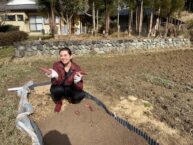This semester, I volunteered at the Muromachi Jidoukan for my CIP. Similar to what we would call in America an after-school center or a children’s center, a Jidoukan is a place where school-aged children stay after their classes are over but before their parents are finished working for the day.
I was initially interested in volunteering to work with children because I tutor after school at a public middleschool as part of my workstudy scholarship in the US. Working with children is something I enjoy doing regardless, but it’s also a great way to familiarize yourself to a culture that might seem a little alien to you (and vice versa).
Similar to my own experience as a newcomer to Japan, many of the children I worked with were also trying their best to figure out how to navigate the social situations they found themselves in. This dynamic was not only really fun and oftentimes silly, but also insightful to understanding the role of community and education in the raising of children in Japan. Part of children’s education is the introduction of concepts of proper social behavior. Because I wasn’t yet accustomed to many of these social situations either, volunteering at the Jidoukan became an opportunity to learn and become accustomed to Japanese society in a hands-on fashion. For example, because everyone in my host family was already an adult, I wasn’t really familiar with how adults speak to children in Japanese. I was able to observe things like the difference in a child’s reaction when you give a command using the て form of a verb versus the なさい form. Moreover, it was fun and gratifying to build a bond with various children there. It was a process wherein I went from an outsider to understanding how I could fit into the environment of the Jidoukan.
The structure of a typical afternoon at the Jidoukan depends on the day of the week. Some days, the children are expected to work on their homework before being able to move onto more fun activities and games. On Wednesdays, the children would compete with each other or against their previous records with various skill-testing toys. For example, the children would take turns trying to see how many times they could juggle with the kendama. My role was to record the count in a special booklet that contained all of their records.
One particularly funny anecdote was that, since the pronunciation of my real name is unfamiliar to most people, I went by ピーター at the Jidoukan (Peter is my middle name, and I do the same at my workstudy job in America). As my bond with the children became stronger, second-grader jokingly called me ピーター君 instead of ピーター先生 or ピーターさん. I only realized this difference when I noticed the other children giggling, and I was happy that they felt comfortable around me enough to make those kinds of jokes with me. By the time I was done volunteering at the Jidoukan, my nickname among the kids was ピーターパン.
Working with the children was certainly the highlight of my experiences, but I was also able to participate in a lot of important interactions with the staff of the Jidoukan. Because they were all extremely kind and understanding, it felt like a low-stakes environment where I could practice more formal speech patterns that are necessary in everyday business in addition to gaining more experiences interacting with my own peers who had already entered the workforce. One of the employees at the Jidoukan was a young man about my age, and we had a lot of conversations about work, college, and job searching activities. Exchanges like this were valuable to me because they showed a little about the attitude that young Japanese people have towards important parts of their lives like career.
Overall, my time at the Jidoukan was one of the best experiences I had in Kyoto. To the children, I could just be a new, friendly face, and in return they made me feel part of the community there. My only regret is that I couldn’t spend more time with the children I had come to know, and that I couldn’t offer a proper goodbye.

